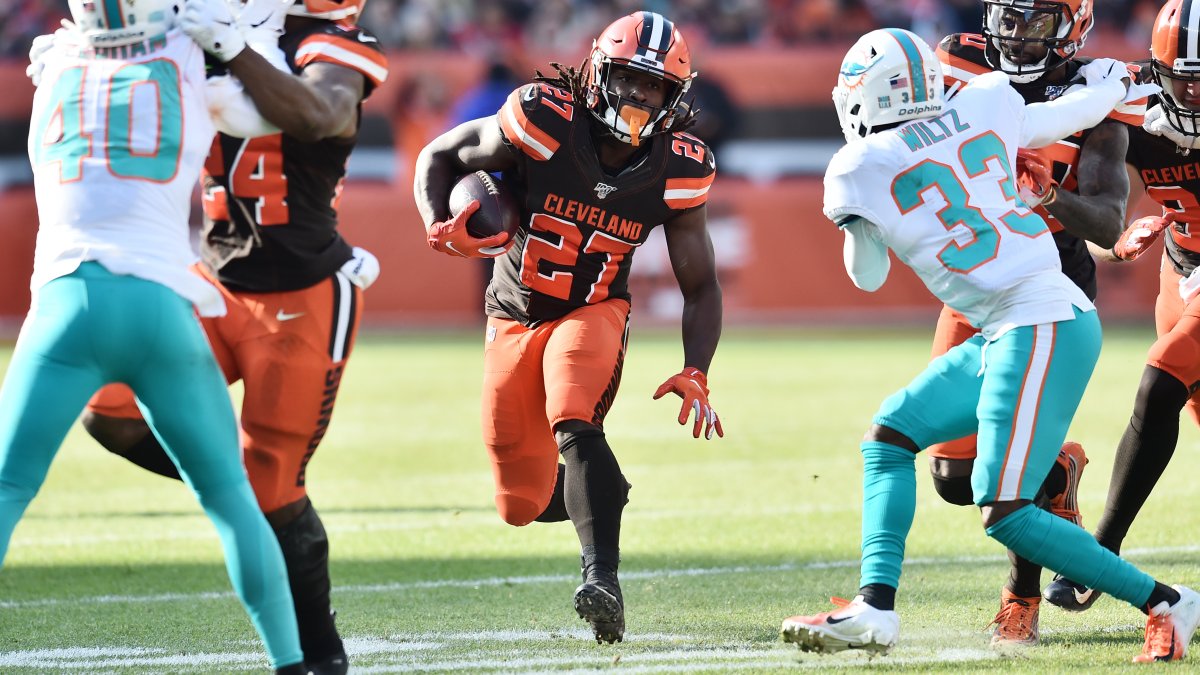In 2019, the top-10 running backs in terms of total targets averaged 89.9 targets. On those same teams, the top tight ends averaged 52.4 targets. Conversely, the top-10 tight ends in terms of total targets averaged 99.8 targets. The top running backs on those teams averaged 53.6 targets.
Only two teams had a tight end and running back both rank in the top-10 in terms of total targets: the Carolina Panthers and the Dallas Cowboys.
[Editor’s note: Subscribe to PFF ELITE today to gain access to PFF’s Premium Stats and new Player Grades experience in addition to the 2020 NFL Draft Guide, 2020 Fantasy Rookie Scouting Report, PFF Greenline, all of PFF’s premium article content and more.]
I bring this up to further discuss the relationship between running backs and tight ends in fantasy football. From the initial figures I have mentioned, it appears that it is rare that a team can support both a tight end and running back in terms of top target share. In 2019, we saw several examples of a running back thriving in the passing game with no tight end of consequence to compete for targets.
Leonard Fournette ranked fourth in the NFL in total targets at the running back position while the Jacksonville Jaguars’ leading tight end, James O’Shaughnessy, had 20 total targets in five games. At the same time, Tarik Cohen saw a career-high 102 targets with the Chicago Bears while Trey Burton led the team at tight end with just 23 targets. When Kareem Hunt returned from suspension, he ranked sixth in the NFL in targets at the running back position, and his 43 targets from Weeks 9-17 were more than all the tight ends on the Cleveland Browns combined (29). This trend also applies to tight end production, as there were also examples of tight ends thriving in offenses without an impact pass-catching back.
Mark Andrews ranked fifth at tight end in targets, while no team passed less to running backs than the Baltimore Ravens. Tyler Higbee enjoyed a late-season breakout from Weeks 13-17, ranking third in yards per route run at the position (3.16) and averaging over 10 targets per game over that span. Meanwhile, running back Todd Gurley II was averaging just 2.8 targets during that same time frame.
Data Collection
It appears that in several situations, tight end and running back targets are negatively correlated to one another. When I compared running back and tight end total targets from 2019, the resulting correlation was -0.33. When I compared running back and tight end target share of the offense, the correlation was even stronger at -0.40. This was the metric I wanted to see more data with, as it mitigates the influence of teams that sit in the top or bottom percentiles in terms of raw passing attempts.
To get an even better understanding of the relationship, I collected total running back target shares and tight end target shares to see if this trend has been seen in previous seasons. Including all seasons dating back to 2013, the negative correlation between the target share was still present at -0.34. So, how can we leverage this for fantasy football?
Why Does This Matter?
Looking ahead to 2020, we can identify several running backs and tight ends who will be competing for targets in their respective offenses. Take the Cleveland Browns, for example, who relied on Hunt last season as a receiver with injuries to the tight end position. That is not the case in 2020, after the acquisition of Austin Hooper, so projecting Hunt to see the same type of pass volume in 2019 seems unlikely.
The same could even be said for elite tight ends like Travis Kelce, who will now have more competition for targets closer to the line of scrimmage with the addition of pass-catching savant, Clyde Edwards-Helaire.
Then figure a team like the Atlanta Falcons, who have brought in both Gurley and former first-round tight end Hayden Hurst. These two are likely going to compete for third in the pecking order for targets in a high-powered offense, which is extremely enticing for fantasy football.
You can also use this knowledge to try and find the next breakout tight end — just identify an offense that does not heavily feature their backs in the passing game. Jonnu Smith is a perfect example with the Tennessee Titans, a team that does not feature Derrick Henry enough as a receiver.
This can also help you manage your roster in-season. When a significant running back or tight end goes down due to an injury, look to the other position to see that target increase.
Conclusion
It’s never been a coincidence that we saw James White be hyper-targeted whenever Rob Gronkowski missed time, or that Jamaal Williams and Aaron Jones were the highest-graded receivers behind Davante Adams in an offense with Jimmy Graham operating as the primary tight end.
Now it is just a matter of buying more into running backs who do not have high-end tight end talent to compete with and vice versa (e.g., David Montgomery, Mike Gesicki). The same goes for acquiring fewer running backs and tight ends who have high-end competition in 2020 (e.g., Raheem Mostert, Noah Fant).
Finding players with a higher likelihood of opportunities will lead to fantasy success.



 © 2024 PFF - all rights reserved.
© 2024 PFF - all rights reserved.